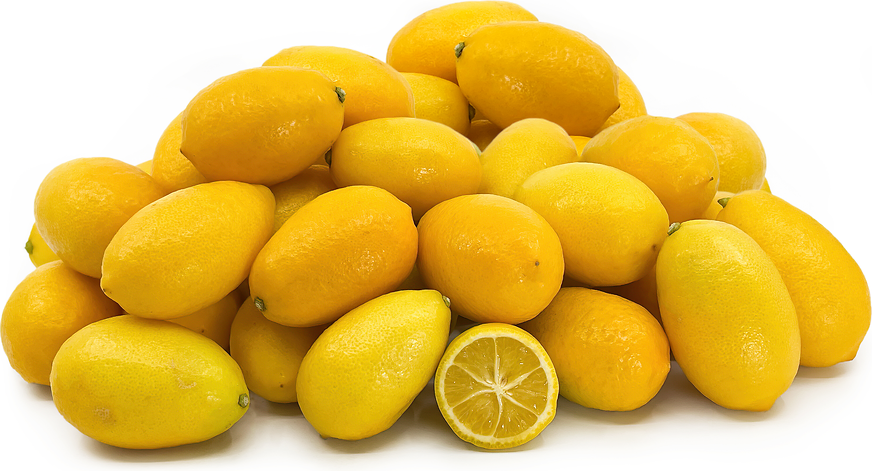


Spanish Limequats
Estimated Inventory, lb : 0
Description/Taste
Spanish Limequats are small fruits, averaging 3-4 centimeters in diameter, and are globular, oval, to oblong in shape. The thin peel is smooth, shiny, pocked with oil glands, and ripens from green to yellow with maturity. Underneath the peel, the flesh is soft, pale yellow to green, aqueous, and is divided into 7 to 8 sections by thin white membranes. The flesh also contains a few edible, cream-colored seeds. Spanish Limequats have an aromatic, floral fragrance, and the entire fruit is edible, including the peel, flesh, and seeds. The peel has a sweet taste, while the flesh is acidic and bitter, creating a balanced blend of tangy, bitter-sweet flavors.
Seasons/Availability
Spanish Limequats are available in the late summer through the spring.
Current Facts
Spanish Limequats are botanically a hybrid variety that belongs to the Rutaceae or citrus family. The sweet-tart fruits are a cross between a key lime and a kumquat and are classified as an exotic, specialty cultivar that is challenging to find in commercial markets. The name Spanish Limequat is a general term used to describe three different varieties of limequats, including Eustis, Lakeland, and Tavares. In Spain, Spanish Limequats are a popular home garden variety for their ability to be grown in small spaces and containers and are considered to be highly ornamental, surviving in regions with colder climates. The fruits are also favored for their zero-waste nature, as the entire limequat is edible, and are popularly consumed in both fresh and cooked applications.
Nutritional Value
Spanish Limequats are a good source of vitamins A and C, which are antioxidants that can boost the immune system by protecting the body against external environmental aggressors. The fruits also contain some calcium, potassium zinc, magnesium, iron, and folic acid.
Applications
Spanish Limequats are best suited for both raw and cooked applications such as baking and boiling. The small fruits can be consumed straight, out-of-hand, as all parts, including the peel, flesh, and seeds are edible and have a floral, sweet-tart flavor. Spanish Limequats can be sliced and utilized as an edible garnish, pressed and juiced into cocktails, blended into smoothies, sliced and tossed into salads and fruit bowls, or pickled for extended use. The fruits can also be cooked into preserves, jams, and marmalades, candied whole, dipped in caramel as a sweet dessert, cooked into sauces and chutney, or served with seafood and roasted meats. In cooked applications, it is recommended to remove the seeds prior to heating as the process causes the seeds to release a bitter flavor. Spanish Limequats pair well with tomatoes, zucchini, endive, persimmons, lychee, avocado, lemongrass, rice, vanilla, seafood, and meats such as pork, poultry, and beef. The fruits will keep up to one month when stored whole and unwashed in a sealed container in the refrigerator.
Ethnic/Cultural Info
In Spain, citrus is primarily cultivated in four main regions, including Valencia, Andalusia, Catalonia, and Murcia, with Valencia and Andalusia being the center of cultivation. The two regions produce approximately ninety percent of the citrus found in Spanish markets, and exotic varieties such as Spanish Limequats are increasing in popularity within these regions for their sweet-tart taste and ornamental value. The region of Valencia, which is situated along the coast, is also known for its fresh seafood. Citrus and seafood have developed an integral partnership in Valencian cooking to create sweet, salty, tart, and savory dishes, and one traditional recipe, known as suquet, often uses limequats as a unique finishing flavor. Suquet is a seafood stew that was initially created as a way to use seafood that could not be sold at local markets due to imperfections. The stew incorporates varying ingredients such as tomatoes, potatoes, onions, garlic, and almonds, and limequat juice is used to add acidity to brighten flavors within the hearty dish. In Valencia, Spanish Limequats are also commonly simmered and cooked into a syrup that can be used for both sweet and savory applications.
Geography/History
Limequats are native to Florida and were initially hybridized in 1909 by Walter T Swingle of the U.S. Department of Agriculture. The fruits were released to commercial markets in 1913, and with their introduction, the sweet-tart fruits quickly spread to other countries around the world, including Spain, for cultivation. Today Spanish Limequats can be found at farmer's markets and in home gardens throughout Spain and are often exported to other European countries for sale in local markets.









